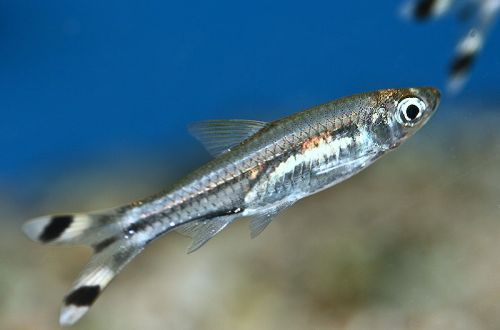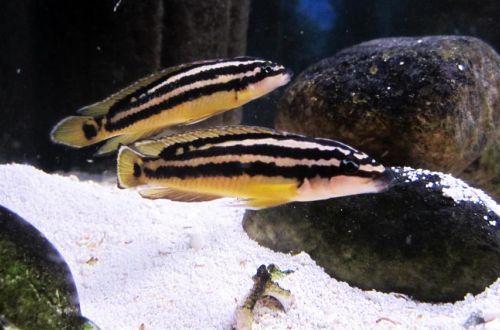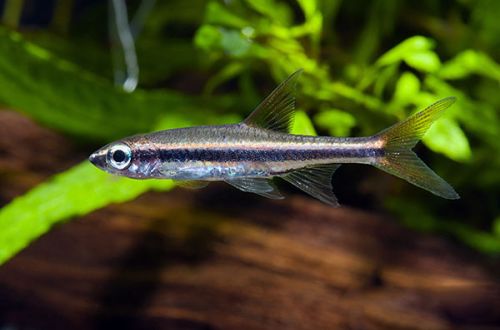
Three Line Rasbora
Trilinear Rasbora, scientific name Rasbora trilineata, belongs to the Cyprinidae family. An excellent choice for a beginner aquarist, the fish is able to successfully adapt to various conditions, unassuming food, hardy. And although the coloring is more than modest, it is probably impossible to call it boring.

Contents
Habitat
It is widely distributed in Southeast Asia on the territory of modern Laos, Thailand, Cambodia, in peninsular Malaysia and the islands of Sumatra and Borneo. It lives both in fast rivers and streams flowing in the litter of tropical forests, and in areas of ancient peat bogs. Individual populations can be found in lakes, reservoirs, and even in flooded coastal areas during the rainy season.
Brief information:
- The volume of the aquarium – from 250 liters.
- Temperature – 22-25°C
- Value pH — 5.0–8.0
- Water hardness – soft (1-12dGH)
- Substrate type – any
- Lighting – subdued / moderate
- Brackish water – no
- Water Movement – Low/Moderate
- The size of the fish is about 15 cm.
- Food – any food
- Temperament – peaceful, active
- Keeping in a flock of 6 individuals
Description
An elegant fish with a swift body shape. Adults reach 15 cm in length, while females are somewhat larger than males. The coloration is silvery, a characteristic feature of the pattern are two dark symmetrical strokes on the tail and a stripe stretching from the base of the tail to the abdomen. From these three bands Rasbora got its name.
Food
Accepts all types of dry, frozen and live foods of suitable size. It is recommended to serve different types of products, which has a beneficial effect on the overall tone of the fish. Feed 2-3 times a day in the amount eaten in 5 minutes.
Maintenance and care, arrangement of the aquarium
It is possible to provide comfortable conditions in a tank from 250 liters with a large free space for swimming. The design does not really matter and is selected from your preferences – it can imitate the bottom of a fast river with a rocky substrate or a section of a peat swamp littered with fallen leaves with numerous snags, branches and tree roots. All decorations, including plants, should be placed along the side walls of the aquarium to keep enough open water for the Trilinear Rasbora to swim freely.
The set of equipment is standard and includes filtration and lighting systems, an aerator and a heater. When choosing a “river” design, you can additionally use devices to create an artificial current. A prerequisite is the presence of a cover, the fish are very mobile and prone to jumping out. Water parameters have wide allowable dGH and pH values, so water treatment is kept to a minimum.
Maintenance of the aquarium consists of a weekly replacement of part of the water (about 15–20% of the volume) with fresh water, regular cleaning of the soil from organic waste and glass from plaque.
Behavior and Compatibility
Peaceful active fish. Keeping a flock of at least 6 individuals, being in a group they show their best color and dismantle their natural behavior. Compatible with many other species of similar size and temperament, the best results are achieved when using fish from the same region of origin as neighbors, for example, Rasbora variegated, Cross barb, Five line barb, etc.
Breeding / breeding
Refers to spawning species, females scatter eggs in the water column, and males at this moment fertilize it. Parental instincts are poorly developed, immediately after spawning, the fish can eat their own caviar and fry that have appeared.
Breeding is recommended to be carried out in a separate tank – a spawning aquarium, in order to protect offspring from adult fish. The design is simple, the main attention is paid to the ground, it should consist of particles of a sufficiently large size that do not fit tightly to each other, forming voids, for example, pebbles or decorative glass beads. When the eggs sink to the bottom, most of them fall into these voids and thus become inaccessible to fish. A similar effect is also achieved when using a fine mesh, which is fixed at the bottom.
Another way to ensure the preservation of eggs is to use low-growing small-leaved plants or mosses such as Riccia floating and Javanese moss, which are planted on most of the surface of the substrate (in this case, the soil can be any). Dense thickets of plants can provide reliable shelter for eggs no worse than special soil.
The size of the spawning aquarium is usually 100-120 liters, half filled. The equipment used is an aerator, a heater and a simple sponge filter of low power to prevent accidental suction of eggs and fry. Spawning occurs in dim light, so at first there is no need for a light source.
The beginning of the mating season will be marked by the fact that the females become noticeably rounder, and the males will begin to actively show signs of attention to their chosen ones. At this point, you should prepare a separate tank and fill it with water from the general aquarium, then transplant several females and the most colorful males there. Spawning can be initiated by adding cool water, lowering the temperature by a few degrees. If you do this in the evening, then by morning it will be possible to get offspring. The easiest way to determine the end of spawning is by females – they will become noticeably slimmer.
The fish are returned. The fry will appear in 18-48 hours, and after another 1-2 days they will begin to swim freely. Feed with specialized microscopic food for juvenile aquarium fish.
Fish diseases
A balanced diet and suitable living conditions are the best guarantee against the occurrence of diseases in freshwater fish, so if the first symptoms of an illness appear (discoloration, behavior), the first thing to do is check the condition and quality of the water, if necessary, return all values to normal, and only then do treatment. Read more about symptoms and treatments in the Aquarium Fish Diseases section.





